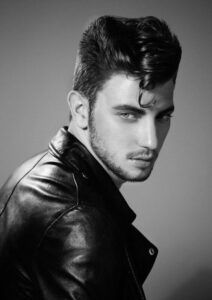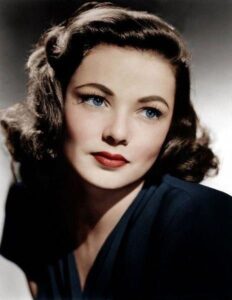INTRODUCTION
In the 1950s hair fashion, was all about glamour and bold styles, reflecting the optimism and changing social norms of the post-war era. Women embraced voluminous, structured hairstyles like the poodle cut and the beehive, while men popularized slicked-back looks and the iconic pompadour. Influenced by Hollywood stars and rock ‘n’ roll icons, 1950s hair fashion became a symbol of individuality and sophistication, leaving a lasting impact on the way people express themselves through their hairstyles.
TABLE CONTENT
- Women’s Hairstyles
- Men’s Hairstyles
- Influential Icons
- Hair Accessories
- Hair Care and Products
- Cultural Impact and Legacy

1950s-hair-fashion

1950s-hair-fashion
Women’s Hairstyles in 1950’s Fashion
The Poodle Cut
This curly, voluminous hairstyle was popularized by stars like Lucille Ball. It featured tight curls all over the head, creating a bouncy, playful look that required regular maintenance and setting.
The Beehive
This iconic style involved piling the hair high on the head and securing it with lots of hairspray, creating a tall, rounded shape resembling a beehive. It was a symbol of elegance and sophistication, often seen on glamorous women like Audrey Hepburn.
Pin Curls and Victory Rolls
These styles involved rolling sections of hair and pinning them in place to create soft, romantic curls or elaborate rolls. Pin curls were popular for everyday looks, while victory rolls, which created a dramatic upswept effect, were often worn for special occasions and nights out.
Men’s Hairstyles in 1950’s Fashion
The Pompadour
Popularized by Elvis Presley, the pompadour featured hair swept upwards and back from the forehead, creating a high, voluminous look. This style required significant use of pomade or gel to maintain its shape and shine.
The Ducktail (DA)
Also known as the duck’s ass, this style involved combing the hair back on the sides to meet in the middle at the back of the head, creating a seam that resembled a duck’s tail. It was a rebellious, youthful look often associated with rock ‘n’ roll culture.
The Crew Cut
This short, tidy haircut was favored for its practicality and low maintenance. The hair was clipped close to the head, with slightly longer hair on top. It was a popular choice for men seeking a clean, classic appearance, often seen on military personnel and college students.
Influential Icons in 1950s Hair Fashion
Marilyn Monroe
Marilyn Monroe’s platinum blonde curls became an iconic symbol of glamour and femininity in the 1950s. Her voluminous, soft waves were emulated by women worldwide, setting a standard for Hollywood elegance.
Elvis Presley
Elvis Presley popularized the pompadour hairstyle, making it a defining look for men in the 1950s. His high, slicked-back hair became synonymous with rock ‘n’ roll and youthful rebellion, inspiring countless young men to adopt the style.
Audrey Hepburn
Audrey Hepburn’s pixie cut, particularly in films like “Roman Holiday,” showcased a chic and sophisticated alternative to longer hairstyles. Her short, neat haircut emphasized her delicate features and became a fashionable choice for women seeking a modern, elegant look.
James Dean
James Dean’s tousled, rebellious hair in “Rebel Without a Cause” captured the spirit of teenage angst and nonconformity. His effortlessly cool style, with its slightly disheveled yet stylish appearance, resonated with young men and contributed to the popularity of casual, laid-back haircuts.
Hair Accessories in 1950s Hair Fashion
Scarves and Bandanas
Women often used scarves and bandanas to add color and style to their hair. Tied around the head or knotted at the top, these accessories were popular for casual and chic looks, offering a practical way to keep hair in place.
Hair Pins and Clips
Hair pins and decorative clips were essential for securing elaborate hairstyles like pin curls and victory rolls. They came in various designs, from simple bobby pins to ornate, jeweled clips that added a touch of elegance.
Headbands
Headbands were a versatile accessory in the 1950s, used to push hair back and create a neat, polished appearance. They were available in different materials, including plastic, fabric, and even adorned with bows or flowers for added flair.
Bows and Ribbons
Adding a playful or feminine touch, bows and ribbons were often tied into hair, either as part of a ponytail or as an accent to other hairstyles. These accessories were popular for both girls and women, reflecting the youthful spirit of the era.
Hats
While not strictly hair accessories, hats were an important part of 1950s fashion. Women wore stylish hats like pillbox hats, berets, and wide-brimmed sun hats that complemented their hairstyles and added sophistication to their outfits.
Hair Care and Products Used in 1950s Fashion
Hairspray
Hairspray was a crucial product for maintaining the elaborate and structured hairstyles of the 1950s. It helped keep hair in place and provided the hold needed for styles like the beehive and pompadour.
Pomade and Hair Gel
Pomade and hair gel were popular among men for achieving slicked-back looks and the high shine of the pompadour. These products provided a strong hold and glossy finish, essential for styles like the ducktail.
Shampoo and Conditioner
Regular hair washing with shampoo and conditioner became more common in the 1950s. Products were designed to clean hair thoroughly and keep it manageable, which was important for creating the polished looks of the era.
Setting Lotion
Women used setting lotions to help set their curls and waves. Applied to damp hair before using rollers or pin curls, these lotions helped create long-lasting, defined curls that were a staple of 1950s hairstyles.
Home Perm Kits
Home perm kits allowed women to achieve permanent waves and curls without visiting a salon. These kits were popular for creating the voluminous, curly styles that were fashionable during the decade, offering convenience and affordability.
Cultural Impact and Legacy of 1950s Fashion
Influence of Hollywood and Television
The 1950s saw the rise of television and the continued influence of Hollywood on fashion. Celebrities like Marilyn Monroe and Audrey Hepburn set trends with their iconic hairstyles and glamorous outfits, shaping the way people dressed and styled their hair.
Emergence of Youth Culture and Rock ‘n’ Roll
The 1950s witnessed the emergence of youth culture and the rise of rock ‘n’ roll music. Icons like Elvis Presley and James Dean became style symbols, inspiring young people to adopt rebellious yet fashionable looks, such as the pompadour and the ducktail haircut.
Enduring Styles and Nostalgia
The styles and trends of 1950s fashion continue to inspire modern fashion and pop culture. The sleek hairstyles, tailored suits, and feminine dresses of the era evoke a sense of nostalgia for a time of post-war optimism and prosperity, making 1950s fashion a perennial source of inspiration for designers and fashion enthusiasts alike.
